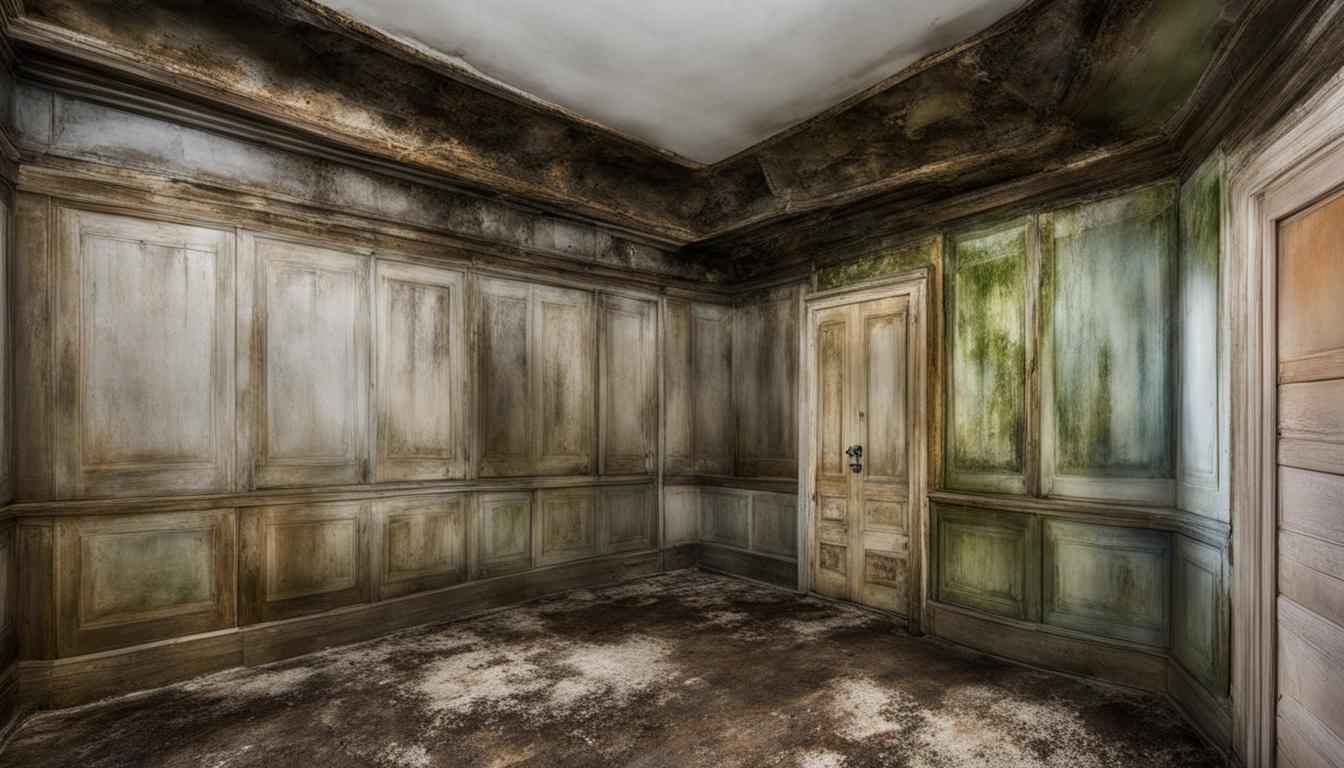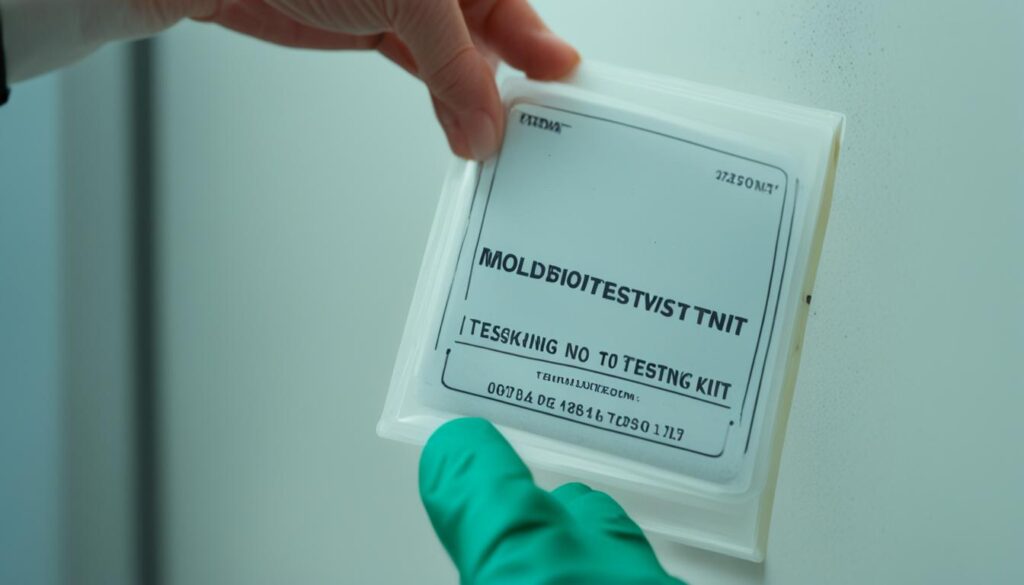
Mold Test Guide: Detect & Address Home Infestations
Welcome to our Mold Test Guide! Protecting your home and health from mold infestations is crucial, and that’s why we’re here to provide you with expert tips and solutions. By effectively identifying and addressing mold issues, you can ensure a safe and healthy living environment for you and your loved ones.
Key Takeaways:
- Understanding the dangers of mold is essential for maintaining a healthy living space.
- Conducting a mold test helps you identify any mold infestations in your home.
- A thorough home mold inspection is a crucial step in the mold testing process.
- Mold remediation involves addressing and preventing future mold growth.
- Seeking professional mold removal services is advisable for severe cases.
Understanding Mold and its Dangers
When it comes to mold, understanding its dangers is crucial for your health and well-being. Mold is a type of fungus that can thrive in various indoor and outdoor environments. While some forms of mold are harmless, others can pose serious health risks.
The dangers of mold stem from its ability to release microscopic spores into the air. When inhaled, these spores can trigger a range of adverse reactions in individuals, especially those with respiratory conditions or compromised immune systems.
Mold can cause:
- Respiratory issues, such as coughing, wheezing, and throat irritation.
- Allergic reactions, including sneezing, skin rashes, and watery eyes.
- Asthma attacks and worsened asthma symptoms.
- Sinus infections and chronic sinusitis.
- Fungal infections in the lungs or skin, particularly in individuals with weakened immune systems.
Preventing mold growth in your home is essential for safeguarding your health. Mold thrives in damp, humid environments, so proper moisture control is key to mold prevention. Ensure proper ventilation, promptly address any leaks or water damage, and regularly inspect areas prone to moisture, such as basements, bathrooms, and kitchens.
Remember, understanding mold and taking preventive measures can help protect your health and maintain a safe environment for you and your loved ones.
Common Mold Prevention Methods
| Mold Prevention Methods | Description |
|---|---|
| Control humidity levels | Maintain indoor humidity below 50% to prevent mold growth. |
| Fix leaks promptly | Address any leaks or water damage as soon as they occur to prevent moisture buildup. |
| Improve ventilation | Properly ventilate areas prone to moisture, such as bathrooms, kitchens, and laundry rooms. |
| Use mold-resistant products | Opt for mold-resistant building materials, paints, and coatings in moisture-prone areas. |
| Regularly clean and dry | Keep your home clean and dry to discourage mold growth. |

Conducting a Mold Test: Step-by-Step Guide
Conducting a mold test is an essential step in ensuring the health and safety of your home. By following a step-by-step guide, you can effectively identify and address any mold issues that may be present. In this section, we provide a detailed overview of the mold testing process, which includes a thorough home mold inspection.
Step 1: Preparation
Before conducting a mold test, it’s important to gather the necessary tools and equipment. Here’s a list of items you’ll need:
- Mold testing kit
- Gloves
- Face mask
- Protective clothing
- Flashlight
- Tape and plastic bags
Step 2: Identifying Problem Areas
Start by identifying areas in your home where mold growth is more likely to occur. These may include areas with high humidity levels, water leaks, or poor ventilation. Check the following areas:
- Bathrooms
- Kitchens
- Basements
- Crawl spaces
- Attics
Pay close attention to any visible signs of mold, such as discoloration, musty odors, or water stains.
Step 3: Conducting the Home Mold Inspection
Once you’ve identified the problem areas, it’s time to conduct a thorough home mold inspection. Follow these steps:
- Put on your protective gear, including gloves and a face mask.
- Inspect each identified area using a flashlight to look for visible signs of mold.
- Check for any moisture sources, such as leaks or condensation.
- If you find mold or suspect its presence, use tape to collect samples by gently pressing it against the affected area.
- Place the collected samples in a plastic bag, seal it, and label it accordingly.
| Sample Location | Observations |
|---|---|
| Bathroom | Visible mold growth near the shower area |
| Kitchen | Musty odor coming from under the sink |
| Basement | Damp walls with discoloration |

Step 4: Sending Samples for Laboratory Testing
After collecting the samples, it’s important to send them to a reputable laboratory for testing. Make sure to follow the instructions provided with your mold testing kit for proper sample collection and shipping.
Once the laboratory processes the samples, they will provide you with a detailed report indicating the types and levels of mold present in your home.
“Conducting a thorough mold test and home inspection is crucial in identifying any potential mold issues and taking prompt remediation measures.” – Dr. Emily Collins, Environmental Health Expert
By following this step-by-step guide, you can effectively conduct a mold test and identify any mold issues in your home. Remember, if the mold infestation is extensive or if you have underlying health conditions, it’s best to seek professional help for mold remediation. Stay proactive and protect your home and family from the dangers of mold.
Mold Remediation: Addressing and Preventing Infestations
When it comes to mold infestations, addressing them promptly and effectively is crucial for maintaining a healthy living environment. Mold can spread quickly and cause various health issues, so it’s essential to take immediate action. In this section, we will guide you through the process of mold remediation, providing expert advice and solutions.
One of the first steps in addressing mold infestations is identifying the source of the problem. Mold often thrives in damp and humid areas, so inspecting your home for any moisture issues is vital. Once you have pinpointed the source, it’s crucial to fix it to prevent further mold growth. Repairing leaks, improving ventilation, and reducing humidity levels are effective strategies for preventing mold from recurring.
Depending on the severity of the mold infestation, different methods of mold removal may be necessary. In mild cases, you can try using DIY cleaning solutions and techniques. However, it’s crucial to note that improper cleaning can agitate the mold spores and exacerbate the issue. For more severe cases, it is highly recommended to seek professional mold removal services. Professionals have the expertise and specialized equipment to safely and effectively eliminate mold, ensuring thorough remediation and preventing its regrowth.
Prevention is key when it comes to mold growth. Regular inspections and maintenance, especially in areas prone to moisture, can help you identify and address mold issues at an early stage. Additionally, implementing preventive measures such as proper ventilation, using dehumidifiers, and promptly drying out wet areas can significantly reduce the risk of mold infestations. Remember, addressing mold infestations and preventing mold growth go hand in hand for a healthier and mold-free home.




